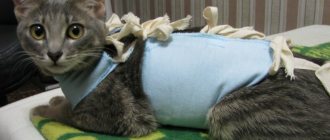Why do you need a blanket?
blanket (bandage) – a fabric covering prescribed for cats to wear after surgery
Veterinarians everywhere prescribe so-called blankets for cats during the postoperative period. A blanket, also known as a bandage, is a fabric covering that covers the entire abdomen and chest of a pet, thus preventing the animal from reaching postoperative sutures. The need for it is due to the fact that cats often not only actively lick the stitches, but also try to chew out medical threads on the incisions. And since in most cases the sutures need to be treated with medications several times a day, at least in the first days after surgery, and ingestion of such medications by animals is undesirable, the bandage also helps protect the cat from poisoning with antiseptics.
Depending on the nature of the operation, a blanket can be put on the animal in a veterinary clinic, or its wearing is prescribed as necessary, so owners must clearly understand not only how to put a bandage on their pet, but also what to use when choosing it.
How to sew a blanket for a cat
Start by choosing your material. You can use elements of your old clothes, then they will calm the cat with your smell. For blankets, old thick tights or leggings or trouser legs are suitable. In this case, you can simply cut holes for the paws in them and secure them firmly with a knot around the neck. If you sew a bandage from scratch, you need to start by taking measurements: the girth of the abdomen and the length of the body, from the neck to the tail, the distance from the neck to the front paws and from the tail to the hind legs. Using these values, start drawing your pattern:
- Draw a rectangle, where the width is the circumference of the abdomen, and the length is the length of the torso. Don't forget about allowances.
- Measure the required length and place the notches for the animal's hind and front legs.
- Attach a tie to each corner: ribbon or rope.
Do not choose material with unstitched areas, as any thread caught on the seam can cause rotting.
How to choose a device
choose products in transparent packaging, study in detail the quality factor of the bandage
For a speedy recovery of your pet, it is important that the blanket meets a number of requirements:
- Materials. It is better to opt for natural cotton products, so air will easily flow to the wound, which reduces the risk of inflammatory processes and suppuration. The ideal materials for a bandage would be a combination of cotton and lycra, but the inclusion of synthetic fibers will not negatively affect the quality, but on the contrary - it improves the stretchability of the fabric and does not hinder the animal’s movements.
- Quality of tailoring. All seams of the device should be strong, but be neat so that the cat cannot tear them in an attempt to get rid of the bandage. Even numerous ties of the product should have a stitch around the perimeter. This will extend the service life during subsequent washes and prevent “fraying”. After all, even a small thread getting on a healing wound can result in rotting of the seam and a deterioration in your pet’s well-being.
- Selected size. Mass produced blankets come in three sizes: S (for small cats), M (for medium cats) and L (for large cats). Given your pet's individual characteristics, choosing the perfect bandage for her may not be easy. In this case, the blanket can be sewn by hand.
- Colors. On a light-colored or plain product, various stains will immediately catch your eye, which means they will be a signal to you that the blanket needs to be washed.
- Package. Keep in mind that in a pet store you are unlikely to be allowed to take the blanket out of the package and try it on the animal. You can only visually, through the package, evaluate the quality of tailoring of the bandage. Therefore, choose a product in transparent packaging; unfortunately, unscrupulous, low-quality products are packaged with a bright design.
How to properly put on and tie a blanket on a cat
The postoperative bandage is worn correctly if it fits snugly to the pet’s body and does not dangle or sag.
Instructions:
• The pet should be laid on its side (right or left - as convenient for the owner). • The edges of the blanket are brought together and tied with ties, starting with the head ones. • And now – attention. The second garter is tied diagonally (crosswise) to the corresponding ends of the third. This is necessary for better fastening. • Belly ties are tied as usual. • The last and penultimate (not counting the area for the tail) fastenings are also tied diagonally.
The ties do not need to be pulled tight. The bandage should be worn so that it does not dangle or sag, but you can stick your little finger between it and the body. If you tighten the nodes, you can disrupt the local blood supply. Make sure that the edges of the ties are not too long.
Instructions for putting on
most often the blanket is put on the cat right in the veterinary clinic
Most often, the blanket is fixed to the cat’s body using ties, but there are also options on sale with Velcro and zippers. It is easier to dress an animal in a bandage with Velcro or a zipper, but such products are usually much more expensive.
As you already know, most often a blanket is put on a cat right in the veterinary clinic; in most cases, at this time the animal is still under anesthesia or only partially conscious. In this state, the purr offers no resistance, which greatly simplifies the task. If difficulties arise, seek help from the veterinary clinic staff. Now the main thing for you is not to make sudden movements when manipulating the animal’s body, be extremely careful - fresh stitches are very easy to damage!
Subsequent times, when removing and putting on the bandage to treat the wound, you will have to deal with an active animal. It is important to act as calmly as possible. If your pet is noticeably nervous, try to calm him down with petting and a gentle voice.
DIY cat blanket: step-by-step instructions
When you make it yourself, you have the opportunity to choose the size and choose natural fabric.
Parameters for the pattern:
- chest volume;
- body length;
- distance between paws.
Using the pattern, cut out the part and begin attaching Velcro or ribbons. When drawing, add a centimeter to the measurements to process the edges.
Recommendation! The edges of the product must be processed.
Ribbons are made from leftover fabric, sewn on by machine or by hand. The ties rarely come undone on their own. The long edges cling to the animal; it is recommended to shorten the finished ribbons. Velcro makes the process of removing the bandage convenient, but they are purchased additionally. They do not interfere with the cat's movement. Over time, the surface becomes non-sticky.
For large wounds, two-layer or three-layer protection is made. A pad is placed in a multi-layer bandage to absorb secretions. Changed periodically. Double or triple blankets are durable. During the sewing process, several layers are connected, leaving a hole for the gasket. Choose lightweight, breathable fabric.
Rules for tying on an animal
scheme for attaching a blanket to a cat
Let's focus on how you can put a blanket on a cat. First, make sure that the bandage is positioned correctly on the table, the reference points are symmetrical cutouts for the front legs. The cat's head should be slightly in front of them, and the cutouts themselves should be in the area of your pet's front armpits.
A standard blanket has 7 pairs of laces for fixation, symmetrically located along the side edges of the product. They have to be tied on the back of the animal. Considering that you will often have to remove and put on the bandage, you should not make the knots too tight. However, too weak a fixation can create problems: the cat will be able to untie the laces with its teeth and get rid of the bandage.
- You need to tie the blanket correctly starting from the head. Taking the two laces at the front, fix them on the purr's neck.
- The next two pairs of ribbons need to be tied crosswise on the animal’s shoulder blades, that is, the right tie from the third pair is connected to the left tie from the second pair, the right tie from the second pair is connected to the left tie from the third pair. So you should get a crosshair made of ribbons on your pet’s withers.
- The following laces are tied in pairs on the back.
- The last two pairs of ties should be secured crosswise on the back of the animal's body.
When fixing the blanket, do not squeeze the animal’s body too much. If you notice that the cat's movements have become constrained, slightly loosen the lacing. Also make sure that the bandage does not cover the animal’s excretory openings: the anus and urinary tract. Otherwise, due to discomfort, the animal will try to remove the post-operative bandage, and you will be faced with the fact that the blanket will very soon be dirty.
If the wound on your pet’s body is small, it is not necessary to completely remove the blanket to treat it - free only that part of the body where the surgical suture is located, this way you will save your time and your pet’s nerves in the process of fixing the bandage. When tying ribbons, do not leave long ends. Remember that your cat can easily pull them with his teeth, loosening or untying the knot.
It is allowed to remove the bandage for 15-20 minutes 2-3 times a day, especially if the cat does not get used to it well. However, at this time the pet should be under your close attention. When trying to lick stitches and wounds, you must immediately gently prevent this: caress the animal or distract it with food.
It's best to have another blanket just in case. You should not rule out the possibility that your pet may tear the bandage with its teeth or get it very dirty, in which case it will be necessary to replace the bandage.
Why is a blanket put on an animal after castration or sterilization surgery?
When castrating or sterilizing, a central or lateral incision is made on the animal’s abdomen, onto which, after the necessary manipulations, 3–5 stitches are applied. To avoid complications and to speed up wound healing, the operated cat is put on a postoperative blanket - this is a large fabric bandage equipped with several pairs of ties or Velcro that are fixed on the back. A blanket for a cat after sterilization is necessary for the following purposes:
- Protection against infection. Through a wound, pathogens can penetrate the skin and cause inflammation.
- Preventing animals from licking external agents used to treat sutures.
- Protection from scratching. Since the incision site is itchy, the cat can scratch it until it bleeds, and damaged skin is an open gate for infections.
- Preserving the integrity of the seams. Without a blanket, the animal can damage the threads holding the edges of the wound together, which will lead to the sutures coming apart.
- Preventing mechanical damage.
- Prevention of abdominal sagging due to weakening or stretching of the muscle walls.
How many days to wear
When deciding how long to continue wearing the bandage, trust your veterinarian
Postoperative care, which is fully the responsibility of the owners, is one of the most important moments, for example, when sterilizing a cat. One of the most frequently asked questions is how long should I wear a blanket?
It is important to understand here that the duration of wearing the bandage directly depends on the complexity of the operation, the size of the wound, the individual condition of the cat and the healing processes. As a rule, after simple surgical interventions, the pet should wear a bandage for 10 to 15 days. However, these terms may vary either more or less.
The problem that you may encounter is that the cat may resist putting on and wearing the blanket, trying with all its might to remove it. Often the pet looks unhappy or is offended by the owners, so there may be a desire to rid the animal of wearing a bandage early. But it is important to remember that the optimal timing for removing the bandage will save your pet from unnecessary problems, and the decision to finally abandon the blanket should be made by a veterinarian.
How to dress correctly?
It is better to tie a blanket while the animal is still under anesthesia.
Adjust the length of the ties so that the loose ends do not interfere with the animal. It is better to immediately cut off the excess so that the cat cannot accidentally get caught on something and injure itself during the owner’s absence.
Observe how the cat behaves. If wearing a blanket for the first time causes stress, remove the product from it and try putting it on again after a while. Don't expect a pet in a bandage to behave the same way as usual, because these freedom-loving animals do not like to have something put on them.
Unfortunately, before sterilizing my cat, I did not accustom her to the sensations of wearing a bandage, so when she woke up after anesthesia, she experienced additional discomfort due to the presence of an extra object on her body. And, having started to rise, she moved only in short dashes and mostly hovered with her paws bent. However, subsequently, after careful care, the movements became less intermittent, and in the end, the cat got used to it.
If the animal is under anesthesia, then putting a bandage on it will be quite simple. Another situation is when the cat resists. Then doing it alone is not recommended. It's better to ask someone at home to help.
Caution: Do not squeeze the cat too hard, as this may cause the seam to come apart. If you need to put a blanket on a cat that has already recovered from anesthesia, act not with coercion, but with affection.
Those who are going to put a bandage on a pet for the first time and feel unsure should practice on inanimate objects, for example, toys, and only then approach the cat.
Sometimes the cat strongly resists and does not allow the blanket to be put on itself. After some time, you can repeat the attempts, because over time the animal gets used to this procedure. As well as, for example, rubbing the eyes.
Step-by-step instruction:
- First you need to tie the laces closest to your neck. Grab your head, but gently.
- Now tie the ones between the neck and front legs.
- Tie each pair of laces towards the tail.
- The last two ribbons must be tied crosswise around the cat's rump.
And do not forget to leave the anus and urethra open. Otherwise, the pet will not be able to go to the toilet normally and will worry or stain the bandage. Make sure that the blanket not only does not cover, but is not too close to the urethra and does not become wet from the animal’s urine.
Sometimes it happens that a cat, after putting a bandage on it, cannot move calmly. Then it is worth loosening the tapes so that the animal does not suffer, because he already needs to recover from the operation.
Postoperative blankets for cats are easy to use. But in order to avoid injury to the animal, it is important to read the information on how to put on this product without harming the pet. If the cat is under anesthesia, there should be no problems with dressing and tying it up. It’s another matter when the animal is conscious, it resists and does not allow the owner to perform the necessary manipulations.
Seam processing
treatment of postoperative sutures is an extremely important point
In addition, you should not miss such an important point as processing the seams. After sterilization, the suture is usually located in the lower abdomen of the animal. In this case, it is better not to remove the bandage completely, so you will save yourself the hassle of putting it on later. It will be enough to untie two or three of the outermost rear laces and bend the edge of the fabric so that it does not interfere with access to the treatment area. Antibacterialization of the wound is carried out with medications prescribed by the veterinarian and at intervals recommended by him, depending on the nature of the medical intervention and the general condition of your pet.
How to care for a cat after sterilization
Blankets for cats after sterilization, ready-made, are sold everywhere. It's rare that you can't buy it. Both in a veterinary clinic and in any nearby pet store you can find this accessory at a fairly affordable price - about 100-150 rubles.
Recommendation: it is better to immediately buy two bandages or even more. After all, anything can happen after surgery.
- The bandage will become dirty with the preparations that need to be used to treat the seam.
- The cat may wet the material while going to the toilet.
Blankets in stores are not sold in universal sizes. Manufacturers usually take into account that cats come in different sizes. Therefore, on sale you can find blankets S, M, L. Sizes, like people’s: small, medium, large.
There is no need to take a blanket as if “for growth.” Despite the fact that it can be adjusted with ties, it is still better to measure the length of the torso first so as not to make a mistake.
There are usually blankets available with drawstrings that are long enough and can be adjusted depending on the size of your cat.
Caring for a cat during the postoperative period is not limited to just purchasing or creating a blanket. It is necessary to provide your pet with increased attention, especially in the first hours after surgery. You need to pick up the animal from the clinic only in a carrier, having previously covered the bottom with a soft cloth or a special diaper.
Special technology allows the diapers to retain moisture inside for a long time and completely block odor
Carefully place the animal in the carrier, always on its right side, and cover it with something warm or place a heating pad or a bottle of hot water on its back. Do not neglect this, because after anesthesia, the cat’s body loses a lot of heat. Another feature of anesthesia is freezing of the eyes when open. To prevent the cornea from drying out, you need to open and close your eyelids every half hour or use special drops.
At home, leave the animal in the carrier or carefully, removing the edges of the diaper, transfer the cat to the floor. Keeping in mind your exposure to cold and drafts, choose a place close to the radiator, but under no circumstances place it close to the heater; excessive heat can cause bleeding. It is necessary to keep the cat under constant observation for 2–8 hours, waiting for it to wake up.
We suggest you read: Bleeding in a pregnant cat, what to do
After the cat recovers from the anesthesia and begins to behave consciously, place a bowl of water and food in front of it. She may not touch the food, because her appetite does not return immediately, but you must definitely monitor it, because this is the main indicator of the animal’s health. It is better to introduce special food for operated animals.
Next, you just need to take care of the seam and observe the behavior of the animal. Check with the doctor who operated on the cat about what medications should be used to treat the wound. Under no circumstances should you engage in self-diagnosis and treatment; a cat’s body is different from a human’s and many medications may simply not be suitable.
The bandage should be worn for 3 days. It should be left only to those animals that are actively trying to lick the wound even through it.
When to remove the blanket?
The period of wearing the bandage also directly depends on the type of seam treatment
The duration of wearing the blanket also depends on the type of seam treatment used by the operating veterinarian. Was it treated with a special spray that protects the seam from harmful bacteria, or was no such treatment carried out?
In cases with the use of a spray, the likelihood of inflammatory processes is reduced. Provided the pet's condition is satisfactory and there are no complications in the suture area, at the discretion of the veterinarian, the maximum period of wearing the bandage can be a week. If the spray was not used after the operation, surgeons recommend wearing a blanket for ten days to be on the safe side.
As we have already said, the veterinarian should have the final say on removing the bandage. Sometimes the decision that a cat should stop wearing a bandage is made for the following reasons:
- The pet behaves extremely aggressively and does not give up trying to remove the blanket (but in this case, the doctor may also prescribe sedatives to calm the animal).
- The cat does not stand on its paws, is afraid to take even a few steps, or stops eating.
- Clear signs of deterioration in the general condition of the animal (nausea, vomiting, tremors, breathing problems, fever or elevated temperature).
- Scuffs and ulcers where the product comes into contact with the skin.
How long should a cat wear a blanket and when should it be removed?
The length of time a cat wears a blanket after sterilization varies from person to person and ranges from 2 to 14 days. This depends on several factors:
- Type of wound treatment. If a protective spray is used, which minimizes the risk of inflammatory processes, the blanket is usually removed after a week.
- Seam material. External sutures made of non-absorbable thread are removed 7–12 days after sterilization. If self-absorbable materials are used and there is no inflammation, the bandage is worn for only 4–5 days.
- Localization of the seam. With a side incision, the wound size is smaller than with a middle incision, so it takes little time to heal.
- Type of surgical intervention. During laparoscopic surgery, only small punctures are made to insert instruments, so there is no need for sutures. Since there is no risk of seams coming apart, it is not necessary to wear a blanket. If it is worn, then only for 2-3 days.
- Seam condition. If no signs of inflammation are observed within 5–7 days, and the cat’s temperature and health are normal, the blanket is removed.
Is a blanket always necessary?
The need for a blanket primarily depends on the nature of the surgical operation
Answer: not always! For example, after sterilizing a cat using laparoscopy, you can do without a bandage, because in this case there is no suture, and the reproductive organs are removed through a puncture. You can also do without a blanket if the surgeon used subcutaneous sutures. For their speedy healing, it is necessary that the skin is constantly open and “breathing”. The bandage is always put on the animal after sterilization along the white line, after abdominal operations and operations on the mammary glands.
We have already mentioned the owners who do not understand the need to wear a bandage and allow their pet to walk without a blanket. But let's look in detail at what negative consequences early withdrawal threatens.
- Dehiscence of sutures due to licking or gnawing of surgical threads.
- External and internal bleeding.
- Inflammation and suppuration of the wound.
All these troubles can overtake your pet immediately, or over the next few days after the cat is freed from the device that was causing inconvenience. You need to understand that if you allow your pet to walk without a blanket, then you will no longer be able to make claims or count on medical care, which many veterinary clinics provide under warranty.
Postoperative blanket: what is it and what is it for?
A blanket is a tight “cover” placed over the stomach of an operated cat.
It serves several purposes at once:
- Protects the postoperative wound from contamination by pathogenic and conditionally pathogenic microflora.
- The blanket prevents the animal from trying to scratch and lick its belly. This is a reflexive behavior of a cat trying to speed up the healing process. But in practice, constant licking of the wound leads to the exact opposite result.
- Also, a pressure bandage pulls the edges of the wound together, which promotes healing by primary intention. Simply put, regeneration in this place will go faster, and not so many reserves of the animal’s body will be spent on it.
- A properly applied and high-quality blanket does not allow the muscular wall of the abdominal wall to stretch too much and weaken. This prevents the belly from sagging in the future.
A cat removes its blanket after sterilization: what to do
if the animal constantly removes the blanket or does not allow it to be put on, it is recommended to use a cat collar
What to do if the cat tries to free itself from the blanket, although the wearing period has not yet expired? It is not surprising that the animal tries to remove the blanket, because the pet is not used to having something on its body. In addition, the pain of the sutures encourages the animal not to give up trying to get to the problem area. It is obvious that the blanket causes discomfort to your pet, but this should in no case be a reason to remove it before the wound has completely healed.
To prevent the cat from trying to remove the bandage, you can temporarily place the purr in a carrier or basket. By limiting your pet's movement, you will prevent him from trying to get rid of the medical device. It happens that the cat still manages to remove the bandage on its own. Most often this happens in the first four days after sterilization, since subsequently the animal gets used to it and behaves much calmer. If this happens, you need to check the seams for possible bleeding, purulent discharge or inflammation; if the external picture is encouraging, you need to immediately fix the product again following the instructions. It is possible that the blanket was tied incorrectly or too loosely.
If the cat is constantly freed from the blanket or does not allow it to be put on, it is recommended to use the so-called “Elizabethan collar” - this is a design that allows you to limit the mobility of the head and effectively prevents the removal of the blanket.
General information
It’s difficult to say when the postoperative bandage was invented. Previously, a cat's actions were limited by a cone - an Elizabethan collar, which was not always convenient in terms of eating and drinking, moving around the room, and washing its face. A blanket or bandage is much more comfortable, and the animal’s recovery occurs much faster.
A patent for a postoperative bandage for cats was received by the Kovalev family in 2002. Their bandage was a cover with Velcro along the spine and on the neck instead of ties.
On a production scale, medical bandages are made from viscose, cotton, meltblown or spunbond. For skin ventilation, the ability of the material to allow air to pass through is important; the fabric must have a natural composition. Some foreign companies produce blankets made of material with lycra. This fabric stretches better and provides the animal with freedom of movement.
You can purchase a bandage on the Internet and in a regular pet supply store. You can buy it at a price of 79 rubles. Before purchasing a pet, the chest girth is measured and weighed. A correctly selected bandage leaves part of the pet's body exposed, not exceeding 8-9 cm. The volume of the blanket will be adjusted with ties. The factory product is designed for cats weighing at least 3 kg and up to 5 kg; it will be difficult to find a similar thing for a small kitten.
If for some reason it is not possible to purchase a belly bandage, below is a story on how to sew a blanket with your own hands.
Medical bandage for pet
To close a wound on the body of a domestic cat, ordinary bandaging is not enough. Feeling pain, the animal pulls off the bandage and chews out the surgical threads, risking infection in the suture. Therefore, veterinarians advise putting a sterile blanket on your pet. It is a blanket with holes for the paws and is tied at the back with ribbons. The device covers the lower part of the cat's body from the neck to the tail.
The main property of the product is to prevent pathogenic microflora from entering the surgical incision. Additionally protects the surface of the wound from sunlight and mechanical damage. When treating a sore spot with medications, the coverlet is partially untied without completely removing it.
Other uses:
- protection of the animal in the treatment of purulent ulcers and eczema;
- fixation of drainage;
- ensuring safety during treatment with acaricides;
- isolation of the tumor in the chest area;
- preventing contamination of animal care items.
We suggest you read: Choosing a cat or a cat, how to choose
The cost of a regular sanitary dressing is quite affordable. In November 2021 it was 75–120 rubles. This is a simple model with ribbons. If desired, the owner can purchase another version of factory tailoring with a pattern and fasteners with buttons, but in this case the price of the product will be from 1,700 rubles. a piece.











